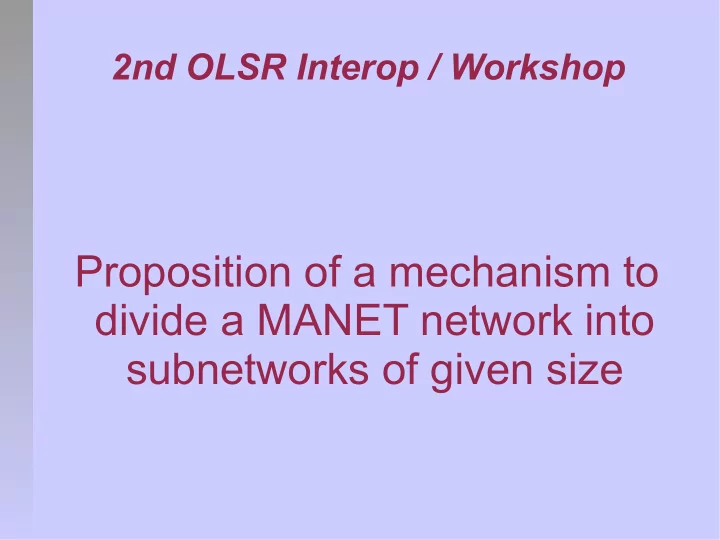

2nd OLSR Interop / Workshop Proposition of a mechanism to divide a MANET network into subnetworks of given size
What are we talking about? Definition ... A subnet is simply defined by the adding of a « subnet identifier » parameter to each node. A subnet must be connex Inside a subnet there is a working scalabil- ity protocol (of course OLSR ;)) ...And dogma No “special” node No additional traffic
So... For OLSR, that means... (first in a static situation) delivery rate 100.00% 90.00% 10 80.00% 30 50 70.00% Delivery rate 70 60.00% 90 110 50.00% 130 40.00% 150 170 30.00% 190 20.00% 10.00% 0.00% 5 15 25 35 45 55 65 75 85 100 110 Number of nodes 30 < Ideal size < 55
By the way... What for??? (yes yes, I assure that we care ;) ) Developing a routing protocol for example
Of course... The other difficulty is in building subnet scale topology ... But that is an other story...
To switch or not to switch that is the (only) question... A node can change its subnet identifier (ie its subnet) when it receive a Hello message from an other subnet's node. (Connexity partially solved) Therefore the only matter is to decide if a network switches its subnet.
“Pressure and Transfer” or “how to manage human (node) resources” Pressure is the “desire” of a node to leave its subnet. Pressure is sent with hellos. When a node receives a “foreign” hello it can compare the pressure and determine a probability to leave its subnetwork given by a “transfer” function. There are two function to be determined : the pressure's one and the transfer's one
Working under pressure... (make us want to leave ;) , nodes too) The process makes the whole subnet to “seek” a low pressure situation. Therefore the pressure must be the lowest for the de- sired subnet size. On the contrary, too small or too large net- works are to be forbidden therefore their pressure is higher.
But... What do we want for subnets exactly? Minimal size (above which the subnet should be “diluted”) Ideal size Excessive size (would lead to inefficiency of OLSR)
Booting (subnet's genesis) “And OLSR said, Let there be subnet : and there was subnet. And OLSR saw the subnet, that it was good” Every node is its own subnet Unique subnetwork identifier (name + iterator?) Non null transfer probability for equal pres- sures Same process for subnet collapse (every node becomes its own subnet)
One stable balanced situation... “a tribute to monogamy” ;)... The goal is that their is only one stable bal- anced situation (the ideal case of course). OR GOOD BAD
Which leads to The slope difference has been exaggerated Flat pressure for large subnet
“Too much pressure here... I quit!” An anonymous node before being transfered Transfer function : By the way... And if we were... lazy? Elementary constraint : “leave for lower pressure” or “nodes aren't masochists”... (To be applied in real life too ;) ) Letting time for “cooldown”
Things are simpler than they seem... (bless be commutativity...) Network size doesn't cheat the results(A*N=N*A)
...But not trivial... ...But not trivial... ...But not trivial... Half life concerns (and Freeman won't help...) With trivial tranfer function ( P(change) = constant * Δ P ) Subnet of a good size but... After 100 seconds of simulation : A half life of only 25 seconds (in other words, around 200 changes in 10 seconds) Reduce parasite changes Make better switching choices Trying to speed up the convergence
(Half) Live longer... Some enhancements : Work on ( Δ P) ² (makes pressure differences more efficient) Divide by subnetwork size (in fact it did cheat a bit...) Some minor upgrades And Finally : P(change)= constant * ( Δ P) ² / (subnetwork size) leads to a 400 seconds half life
Show must go on... Starring : 600 nodes, no mobility, ideal size of 40 nodes, Julia Roberts, NS2 and NAM. (find the intruder ;))
Recommend
More recommend